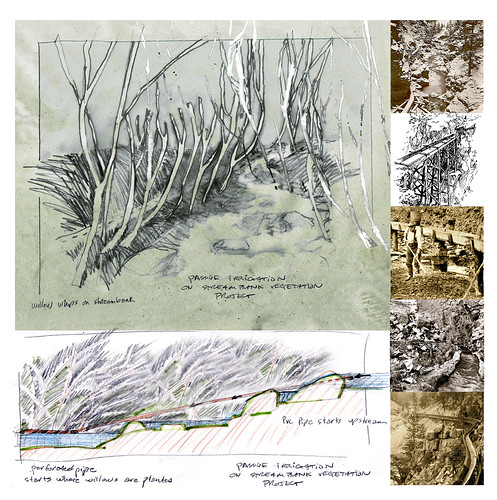Irrigating newly planted willows along creekbed
At a creekside cabin out in the mountains, we want more privacy from the road. A creek flows between the cabin and the road (see photo and description below) We have planted willow whips on the road-side of the creek by cutting wands (or whips) from the existing willows, dipping the ends in rooting hormone (which, ironically, comes from willow) and sticking these in the embankment. To encourage the willows to fill in as fast as possible, we will need to irrigate them during the dry season. Short of installing an automatic irrigation system, we are hoping to install a pipe flume or sluice to bring the water to the willows passively.

Looking upstream in early spring. The road is above the creek, just off the upper left of the photo. It's pretty easy to see the creek and cabin (off the photo on the right) from the road.
Flumes have been used historically to carry water from a natural watercourse to some distance away, without the use of a pump. Flumes were often used in combination with a race or pipe to convey water to mills, mines and agricultural fields.
A flume carries the water at an elevated level above ground. Historically flumes were built of wood, sometimes lined with metal, and mounted on a scaffold to carry the water crosswise along a slope, or mounted on a trestle to convey the water across a depression such as a stream bed or river bed. Pipes could also be used in the same manner, to carry water above ground to where it was needed.
A race is an open channel for conveying water. It can be a simple earth ditch, or it can be lined with timber, metal, concrete or stone. A race or flume system would always start on a watercourse at a location upstream from where the water was needed, either for a gristmill, sawmill, farm fields, waterwheel/water turbine, or a mining operation.
Both a race and a flume would run almost level with just a slight downhill pitch, to carry water to somewhere the stream didn't naturally go. The more gradual the pitch of the race or flume, the farther the water could be carried without using a pump. Historically, a race and/or flume system would range from a short ditch to a water supply channel many miles long, linked to supply water courses and storage dams. If there was a gulch, canyon or other declivity along the course of the race, a flume would be built on a trestle, to maintain a constant fall.
We will need to work out some kinks in the plans, but I like the idea of using old-fashioned methods to create a low-tech solution to challenges like this one. Depending on when we put this idea to use, I'll post updates here at Raven's Nest.



















8 Comments:
Do you need a water license/approval for this? Is there a surplus of undiverted/unused water in Montana especially a dry year like this?
Eva
Yes you need to have a permit and own water rights to surface water in Montana. I'm not sure about ground water. We do have water rights, but even so, the amount of water we are diverting to water the willows about 2 to 4 feet from the creek is minimal and won't be for long -- the roots will reach the water table in a couple of years at most. Good question, though. And no, there is not a surplus of unused water in Montana, at least not perceptibly. I am not sure how that would be measured anyway.
We are planting hemlocks for a windbreak and a barier between us and the road.
When it rains we have developed instant streams that we are diverting to water the trees.
Looking forward to watching your willows grow
lovely illustrations of the willows. i saw your comment on my flickr page, thanks. i'd love to put more of my artwork, ceramics, pods etc on flickr but i reached my 200 limit. sometimes i have pieces on my blog...but i'm shy about showing much.
I'm truly envious of your job. Before I got sick I was beginning to work more in that direction, though not in a professional way, just with friends and relatives who had no clue about gardens and wild spaces.
Cally, come move out to Montana and work with me! :-) You could do it part time and spend the rest of your time making art. I mean art-of-a-different-medium. ahem.
Endment, so good to see you around. I just saw your comment. (i'm a bit slow this time of year) anyway -- it will be awhile before I can post photos of our willows growing ...the deer ate 'em all. bummer! :-[
I stopped by for a lovely view and was not disappointed. I do love those magenta flowers.
Loooooovely drawing, Maureen!!! Dreamy...
hey you wonderful friend! I am sorry I havent written you back since you sent me mail (or flickr) oh, I dont know ... something
I will send you one of these cds! You can have your own before your 75th birthday! ;)
xoxoxo
Kim
Post a Comment